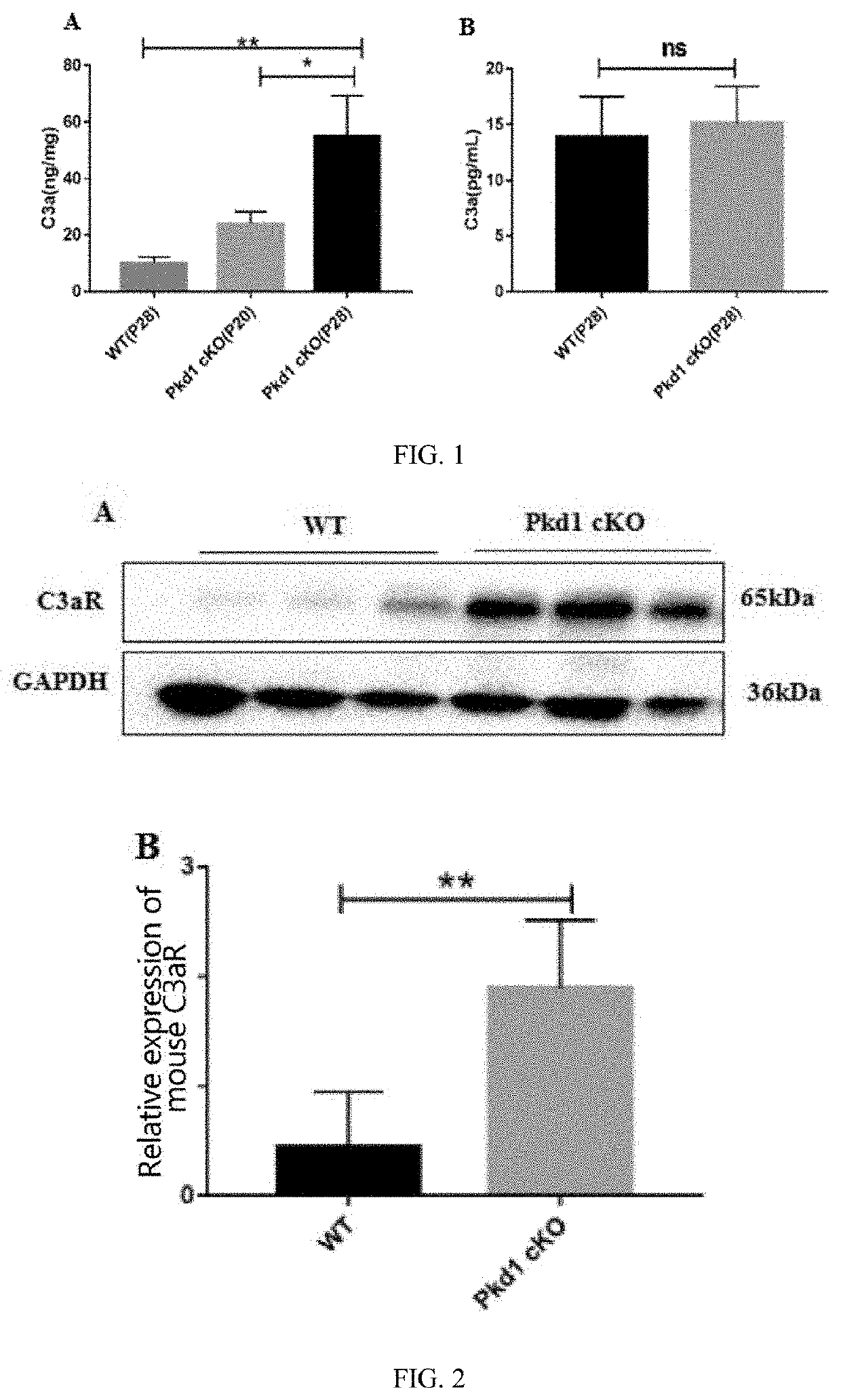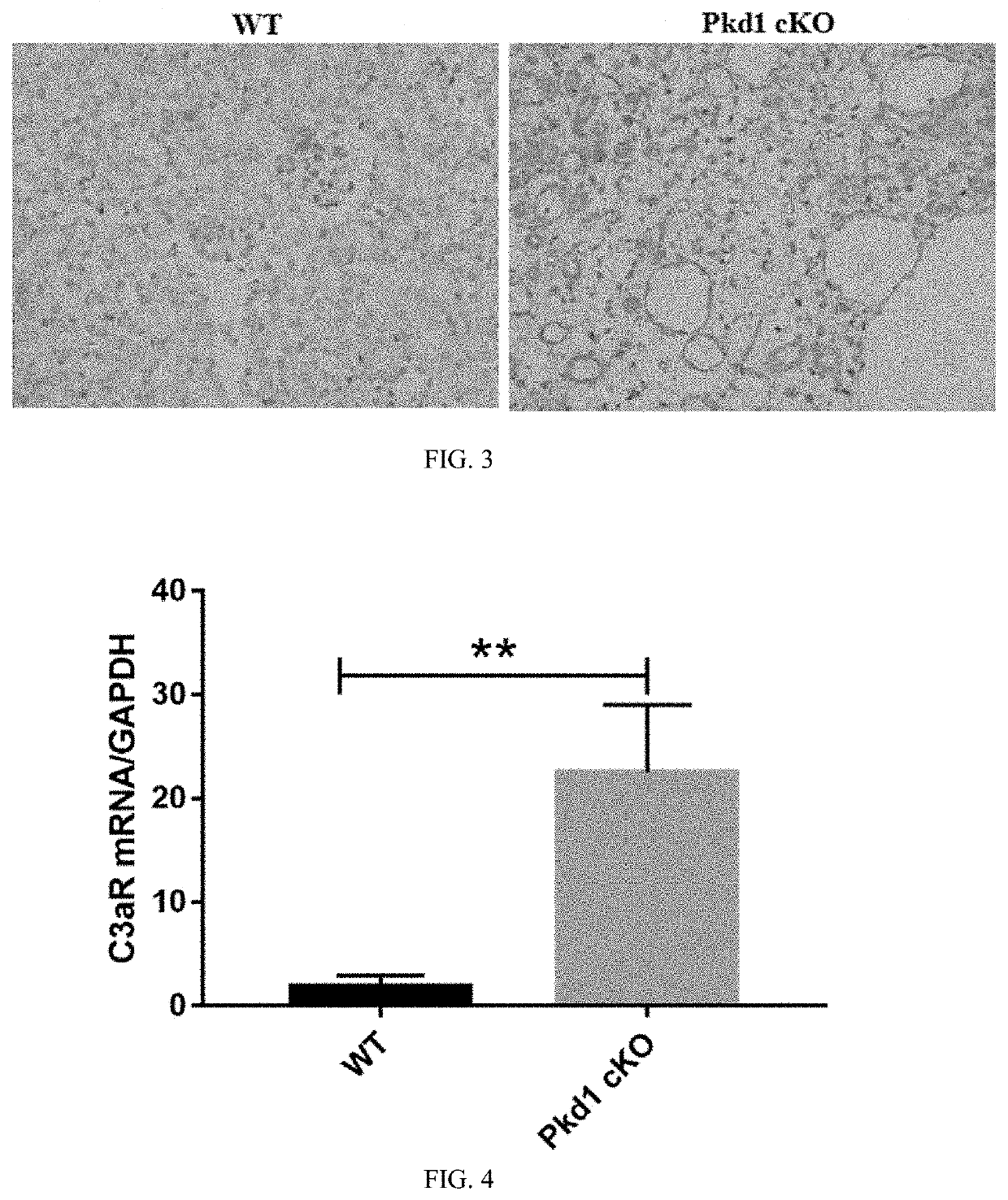USE OF C3aR IN PREPARING DRUG FOR PREVENTING OR TREATING POLYCYSTIC KIDNEY DISEASE
a polycystic kidney and c3ar technology, applied in the field of medicine, can solve the problems of destroying the structure and function of the kidney, unable to treat adpkd with safe and effective treatment medications, and growing kidney cysts
- Summary
- Abstract
- Description
- Claims
- Application Information
AI Technical Summary
Benefits of technology
Problems solved by technology
Method used
Image
Examples
example 1
[0048]Experimental animals: the animals used in this experiment were PKD1flox / flox-Tamoxifen-Cre mice, gifted by professor Wüthrich RP, University of Zurich, Switzerland, and were bred in Specific Pathogen Free (SPF) Laboratory Animal Center of Naval Medical University [License No: SYXK (Shanghai): 2017-0004]. According to study of Klaus et al., PKD1flox / flox-Tamoxifen-Cre mice were intraperitoneally injected with tamoxifen (dissolved in corn oil) at 15 mg / kg at postnatal day 10 to knock out Pkd1 gene, and littermate cre-negative mice served as negative controls.
[0049]Kidney tissues of patients: kidney tissues of ADPKD patients were obtained from the polycystic kidney surgically removed from Shanghai Changzheng Hospital. The tissues with cysts and cyst walls were collected and frozen in liquid nitrogen. The tissues of the unilateral kidney (from kidney cancer patients) removed more than 5 cm away from the side of cancer were taken as controls. All tissue specimens received informed ...
example 2
[0051]Comparison of C3a Levels in the Kidney Tissue and Serum of Wild-Type and Pkd1 Conditional Knockout Mice at Different Stages of Disease
[0052]Serum and kidney tissues from Pkd1 conditional knockout mice at postnatal day 20 and 28 and wild-type mice at postnatal day 28 were taken out to prepare tissue homogenates, and C3a level was detected by mouse C3a Elisa kit (ElabscienceE-EL-M0337c, China) and human C3a Elisa kit (Elabscience, E-EL-H0818c, China). The results were shown in FIG. 1.
[0053]As can be seen from FIG. 1, compared with the wild-type mice at postnatal day 28 (10.11±1.20 ng / mg), the C3a level in the kidney tissue of simultaneous Pkd1 knockout mice (54.89±8.33 ng / mg) increased significantly, P0.05). It is suggested that the increase of C3a induced by complement activation in ADPKD may be mainly localized in the kidney rather than in the systemic system.
example 3
[0054]Comparison of the Expression of C3aR in the Kidney Tissue Between Wild-Type Mice and Pkd1 Conditional Knockout Mice
[0055]Western blot was used to detect the relative expression of C3aR protein in the kidney tissue of wild-type and Pkd1 conditional knockout mice. The results were shown in FIG. 2. As can be seen from FIG. 2, compared with wild type mice, the expression of C3aR in the kidney tissue of Pkd1 knockout mice was significantly up-regulated, P<0.05.
[0056]Immunohistochemistry was used to detect the expression of C3aR in the kidney tissue of wild-type and Pkd1 conditional knockout mice, and the results were shown in FIG. 3. As can be seen from FIG. 3, the number of cells positively stained for C3aR (brownish yellow) in the kidney tissue of Pkd1 knockout mice was significantly increased compared to wild type mice.
[0057]Real-time PCR was used to detect the relative expression of C3aR mRNA in the kidney tissue of wild-type and Pkd1 conditional knockout mice. In the real-time...
PUM
 Login to View More
Login to View More Abstract
Description
Claims
Application Information
 Login to View More
Login to View More - R&D
- Intellectual Property
- Life Sciences
- Materials
- Tech Scout
- Unparalleled Data Quality
- Higher Quality Content
- 60% Fewer Hallucinations
Browse by: Latest US Patents, China's latest patents, Technical Efficacy Thesaurus, Application Domain, Technology Topic, Popular Technical Reports.
© 2025 PatSnap. All rights reserved.Legal|Privacy policy|Modern Slavery Act Transparency Statement|Sitemap|About US| Contact US: help@patsnap.com



